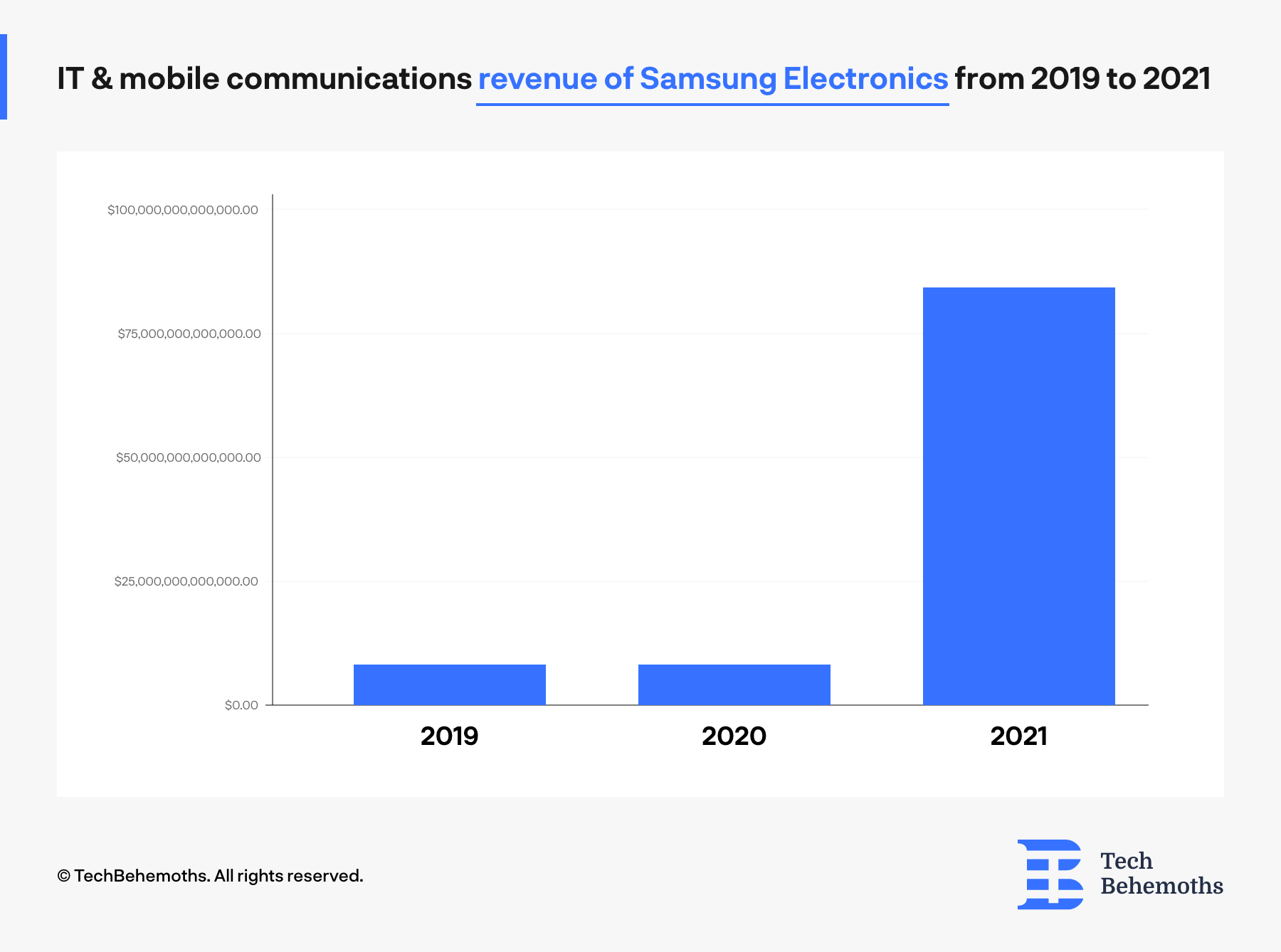How Does Samsung Make Money
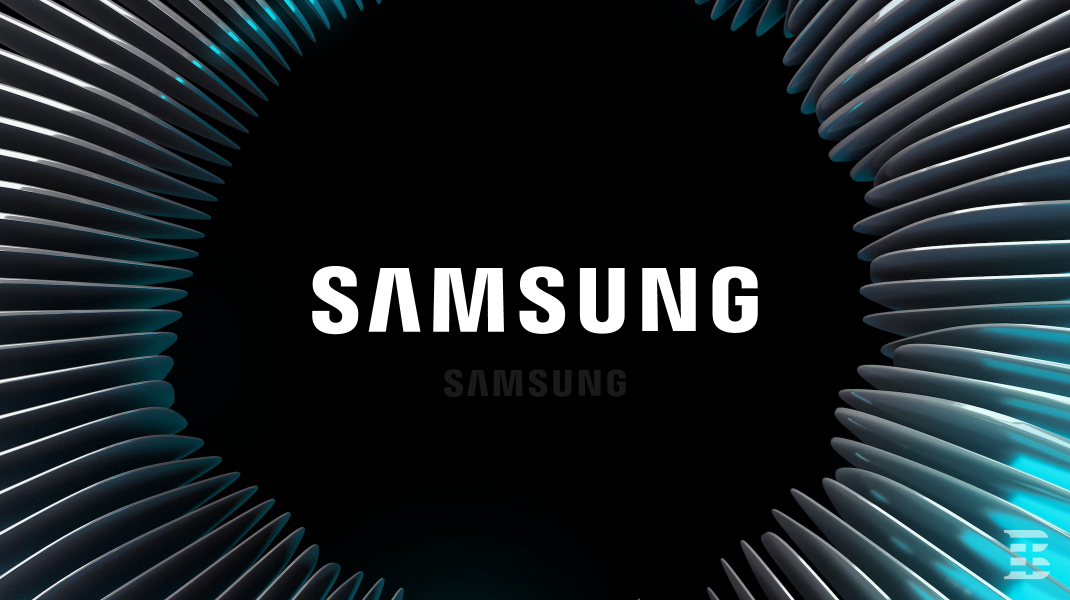
Summary
Samsung Electronics is a global leader in consumer electronics, semiconductors, and mobile communications, with operations across multiple continents. Its main business segments include Consumer Electronics, IT & Mobile Communications, and Device Solutions, which cover semiconductors and displays. The company has invested heavily in advanced technologies, including AI-related memory products, high-performance displays, and premium mobile devices.
In 2024-2025, Samsung maintained stable revenue and solid margins despite market challenges such as inventory adjustments and macroeconomic uncertainty. The Device Solutions Division drives growth, while the Display Division focuses on premium panels and innovation. To maintain its leadership in global technology markets and support ongoing growth, Samsung points to AI-powered solutions and high-end products.
Samsung Electronics is one of the world's largest manufacturers of consumer electronics and components.
The company produces devices, information technology, mobile communications, and consumer electronics. Based on net revenue, the information technology and mobile communications segment is Samsung's largest business division.
For the 2024 fiscal year, Samsung Electronics’ total capital expenditures amounted to approximately ₩53.6 trillion. Based on the 2024 average exchange rate of ₩1,363.09 to $1, this equates to roughly $39.3 billion USD. Of this total, around ₩46.3 trillion (about $34 billion USD) was invested in the Device Solutions (DS) Division, while ₩4.8 trillion (approximately $3.5 billion USD) was allocated to Samsung Display Corporation (SDC).
In this study, we discuss Samsung's business model, its performance in recent years, and what to expect in the future.
Samsung provides solutions to the retail, hospitality, healthcare, finance, education, transportation, and government industries. The company's operations span several continents, including the Americas, Europe, Africa, the Middle East, and Asia-Pacific. The head office of Samsung is in Seoul, South Korea.
Samsung Business Segments Analyzed
The company revenue stream is divided into 3 divisions based on product category, each with multiple business segments. Below you can find the graphical representation of how Samsung's business segments are divided:

- The Consumer electronics segment is represented by regular electronics that, were in high demand, driven by the pandemic-related interest in TVs, smart wearables, and headphones. However, Samsung continues to face increasing competition from China, particularly in the smartphone market.
- IT and mobile communications are represented by mobile devices and communication services. Mobile networks and communications, at Samsung are the company’s goal for creating a complete product portfolio for 5G commercial services. In the previous year, they spent more than $100M on advertising across digital, print, and national TV. A global mobile communication service from Samsung is ChatON which works on all major smartphone and feature phone platforms.
- Device Solutions is the segment represented by semiconductors and displays. Since 1993, they have supplied the global memory semiconductor market and contributed to the growth of the entire global IT market.
Now that we went through each segment, let’s break down how Samsung makes money from each of them in a short yet comprehensive analysis:
How Samsung makes Money from Consumer Electronics?
The growth of Samsung's consumer electronics revenue overall is based on sales of TVs and other products. The projections for its TV revenue were made using its shipping data and ASP increase. Additionally, this is weighted average market growth rates for the markets for refrigerators, monitors, washing machines, and air conditioners to base the growth of its other consumer electronics revenue.
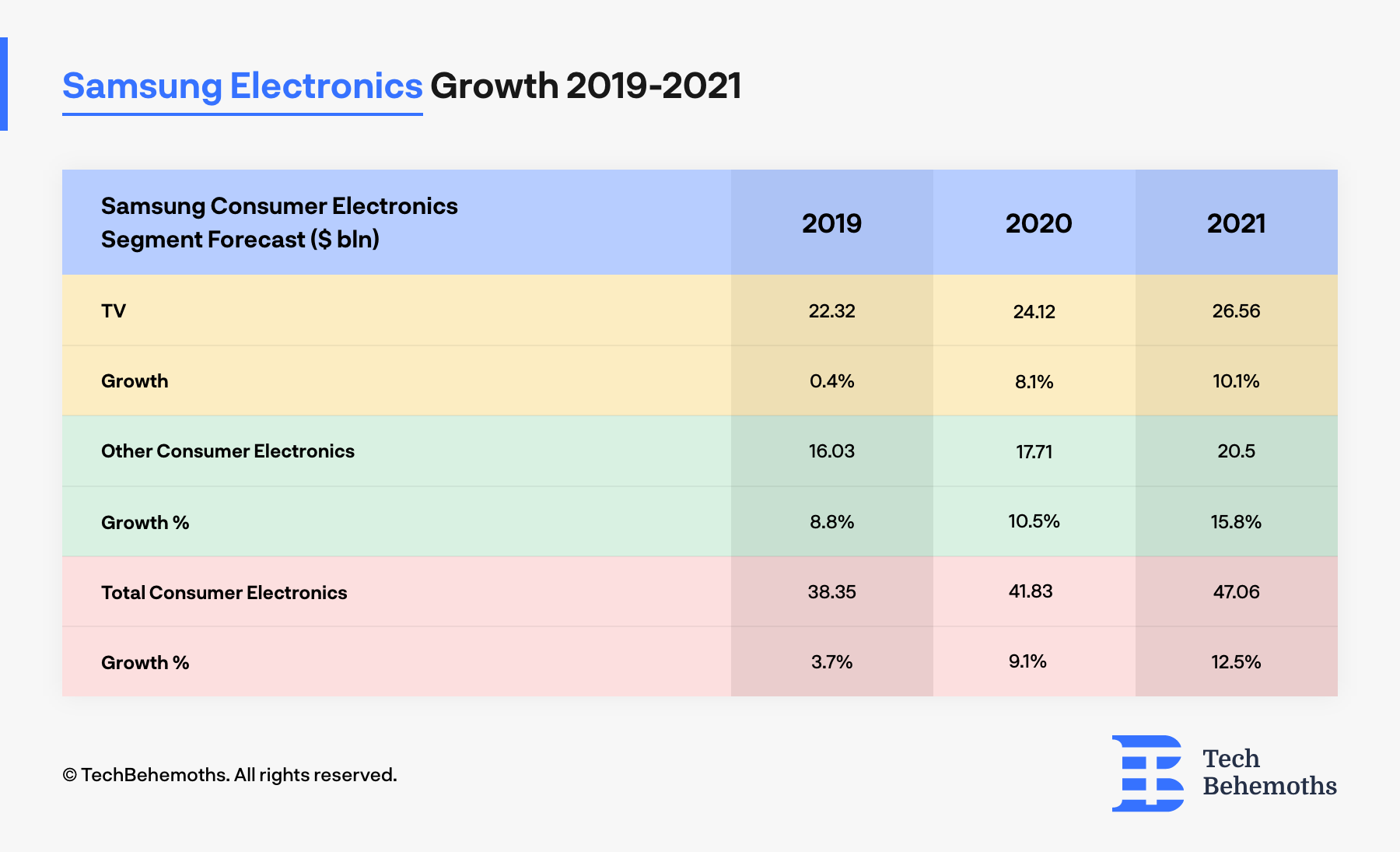
The Memory Business benefited from strong server and AI demand, boosting sales of high-capacity semiconductors and storage products, though earnings were slightly affected by one-time inventory costs. For the second half of 2025, demand for semiconductors related to AI is expected to remain strong, with plans to expand high-capacity offerings. The System LSI Business generated solid revenue from its main semiconductor products, while the Foundry Business faced weak earnings due to inventory adjustments and lower production at older facilities, but plans to increase output and improve profitability later in 2025.
At the same time, Samsung is the second largest seller in the Smartphone market, after Apple. You can learn more about how Apple makes money in our previous article. The pandemic-related increase in consumer expenditure on electronics and appliances was particularly noticeable for Samsung TVs, iPads, and smart wearables.
The rapidly expanding headphone market, particularly TWS earbuds, helped Samsung expand its portable electronics business. Samsung increased its market share in this category, especially in European markets, thanks to the 2017 acquisition of Harman and its brand JBL.
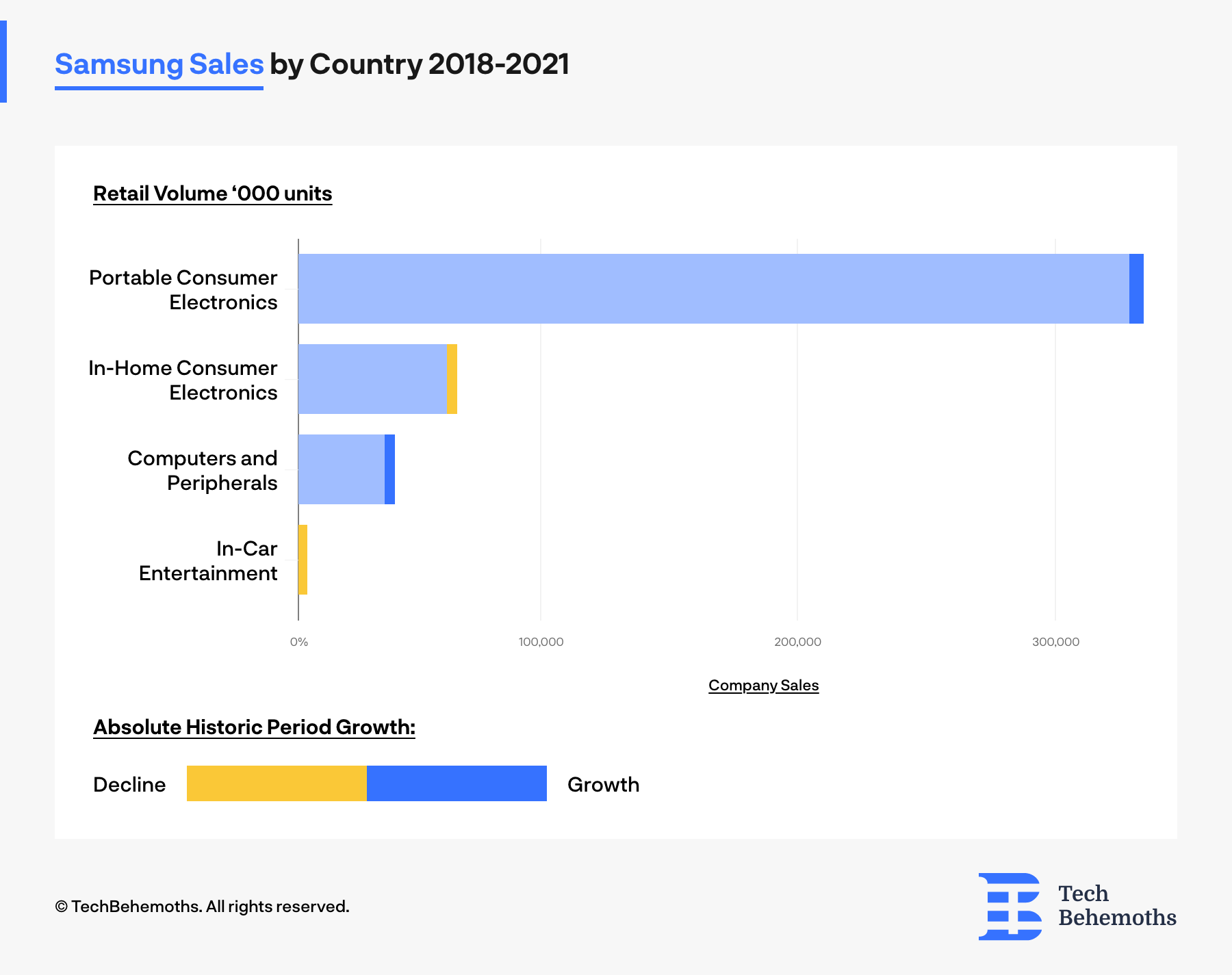
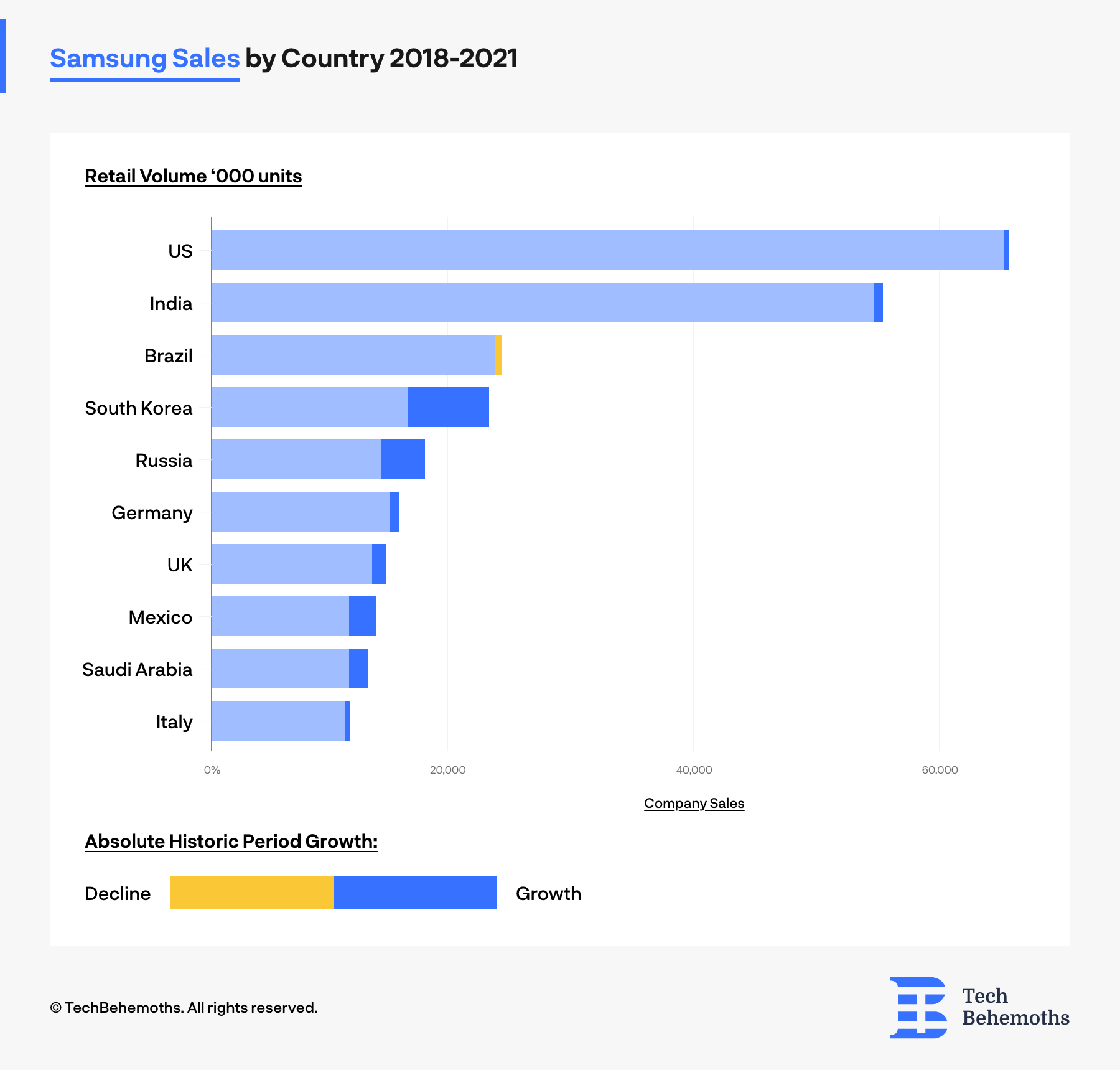
According to Samsung market revenue, this is a weighted average projected CAGR for the market segments for refrigerators, monitors, washing machines, and air conditioners.
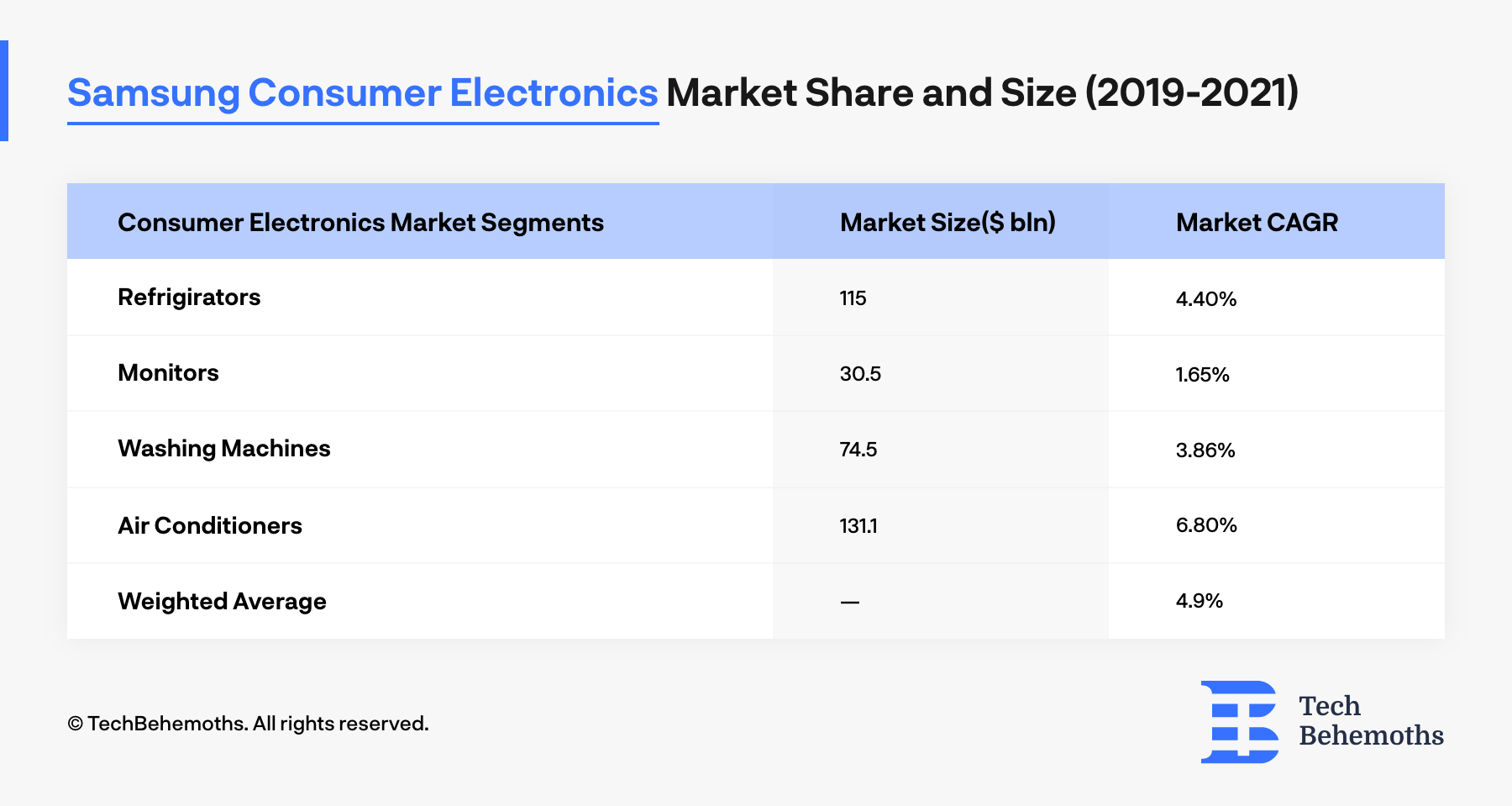
How Samsung makes Money from Information Technology and Mobile Communications?
The IT and Mobile Communications income for Samsung Electronics in 2021 was $766,715M. This was an increase from the lowest recorded value during the survey period from 2020. As we can see, 2019 had a more favorable profit compared to 2020.
But in 2020, the income dropped considerably due to the pandemic, the market was sceptical about buying these products because of the financial crisis generated by COVID-19. Later in 2021 when the pandemic calmed down, sales exploded. People were eager and missed shopping, therefore incomes increased.
Updated information: Samsung's Mobile eXperience (MX) division, which includes smartphones and other mobile products, earned ₩25.8 trillion (around $18.9 billion USD) in revenue for Q4 2024. In Q1 2025, the MX and Networks divisions kept their revenue level steady. Meanwhile, the Device eXperience (DX) division recorded sales of ₩51.7 trillion (about $37.9 billion USD).
How Samsung makes Money from Device Solutions?
The DS division makes money by leading in important markets. It provides advanced semiconductors and display solutions to other Samsung divisions and external customers, including Apple. The division also develops new products to meet the growing demand for AI servers and mobile devices.
The peak revenue of Samsung Electronics Device Solutions (Semiconductor & Display) in 2021 were $2.1B according to The Zippia.
Overall, it is expected that the company's semiconductor business will continue to expand rapidly in 2022, powered by its DRAM and NAND business segments, which are expected to rise by 26.4% and 34.1%, respectively, as the market leader in each of these markets.
Additionally, the company's foundry segment could expand by 17.5% in 2022 as a result of increased output and rumoured pricing rises. Last but not least, we predict that its display panel will continue to expand steadily in 2022 thanks to its substantial exposure to the smartphone display industry, where it continues to dominate the market and advance OLED technology.
Updated information: In Q2 2025, Samsung’s Device Solutions (DS) Division, which includes semiconductors and displays, reported $19.9 billion in revenue. Samsung Display Corporation (SDC) contributed $4.6 billion to this total. The DS division’s growth was supported by strong demand for high-performance memory products for servers, while SDC focused on advancing its display technology to stay competitive.
Samsung Total Revenue and Profit by Segment
Based on net revenue, the information technology and mobile communications (IM) segment is Samsung's largest business division. However, in 2021, the company's largest sales came from the device solutions (DS) segment.
It generated $109.33B in net sales in 2021. Samsung generated $83.76B from the IM segment in 2021 compared to $76.34B in 2020. Its net sales from the consumer electronics (CE) segment in 2021 remained at $42.80B compared to $36.93B in 2020.
The company increased in net sales across all the business divisions in 2021 compared to 2020.
Updated information: Samsung’s total consolidated revenue for the second quarter of 2025 reached $54.7 billion USD, slightly below the $57.9 billion USD recorded in the first quarter. Gross profit for 2Q 2025 stood at $18.7 billion USD, down from $20.6 billion USD in Q1, while operating profit was $3.4 billion USD, compared with $4.9 billion USD in the previous quarter.
Despite these sequential profit declines, Samsung’s revenue demonstrates stability, reflecting continued strong performance across its business segments. The company maintained solid gross margins, while operating profit reflects ongoing investments and operational costs in its core semiconductor, display, and mobile divisions.
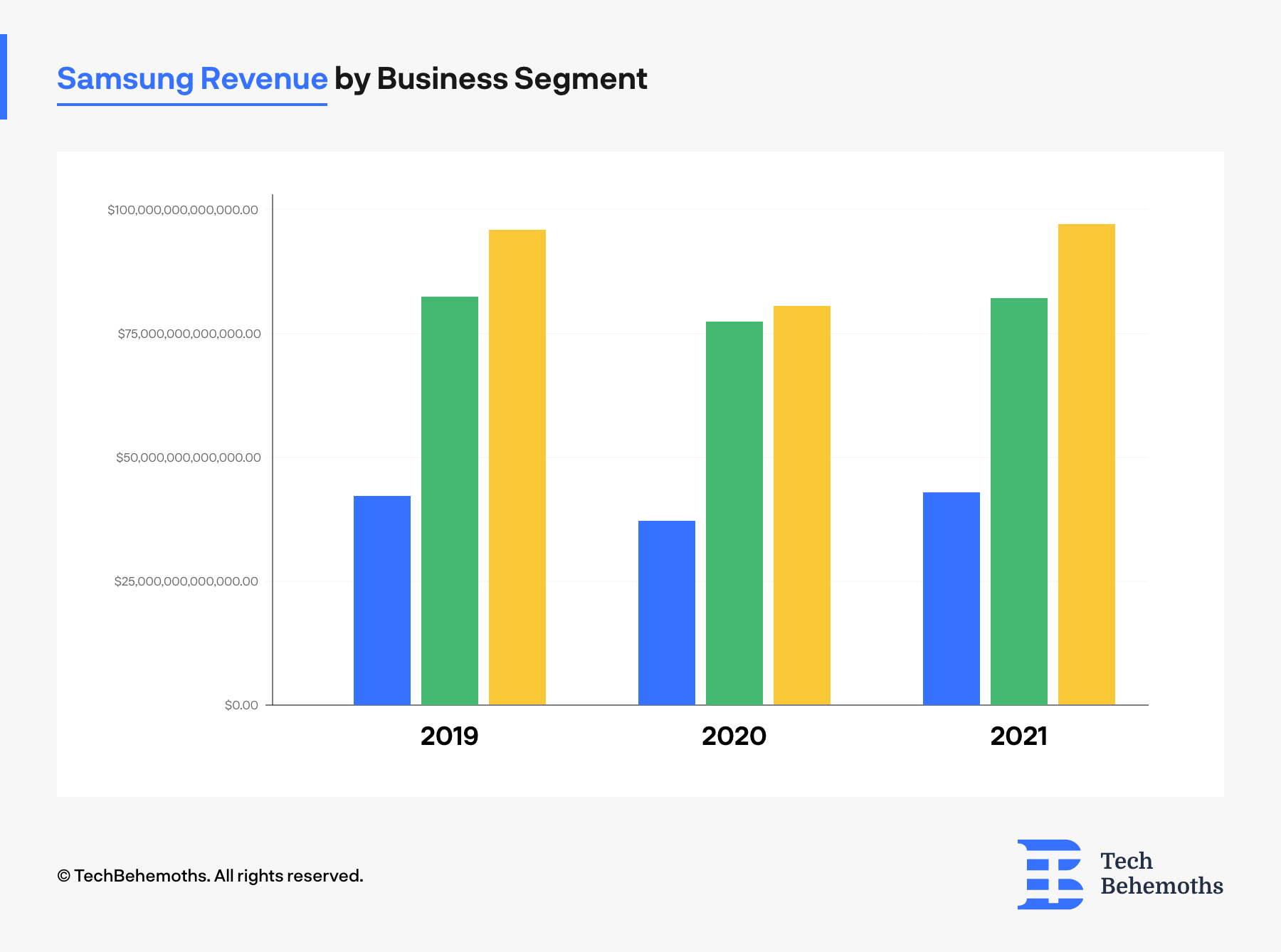
Samsung Total Revenue and Profit 2019-2025
In 2021, the company's revenue was $240.71B, an increase over the previous year's revenue of $203.43B. The revenue of a company is the entire amount of income generated by the selling of goods or services. Unlike earnings, no expenses are deducted.
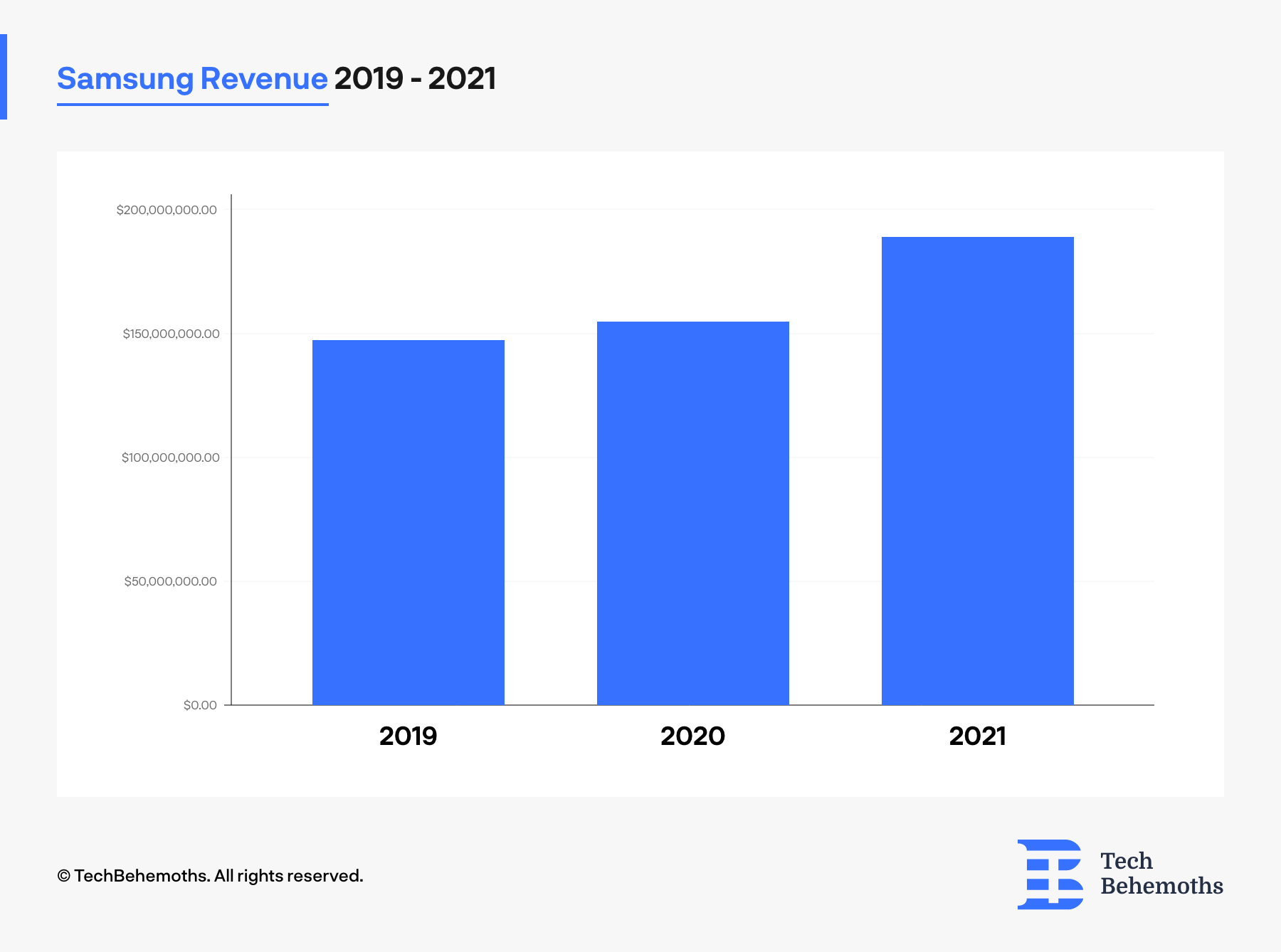
The second half of 2020 has seen a turnaround for Samsung after its profits declined in 2019. In 2021, South Korean tech behemoth Samsung Electronics reported third-quarter earnings of more than $13B.
In comparison to the same quarter last year, this indicates that profits increased by more than 19% and strong consumer demand was the primary driver of higher profits.
According to Samsung, the increasing tendency was particularly strong for microchips and consumer goods. Due to consumers delaying purchases, the smartphone market, which is particularly vital to Samsung, lagged during the whole of 2019.
Demand increased in 2020 and 2021 as a result of new foldable devices and 5G Devices.
As the demand for microchips and other electronics increased because of the coronavirus pandemic, the semiconductor industry, which accounts for more than 80% of the company's profits together with phones, recovered.
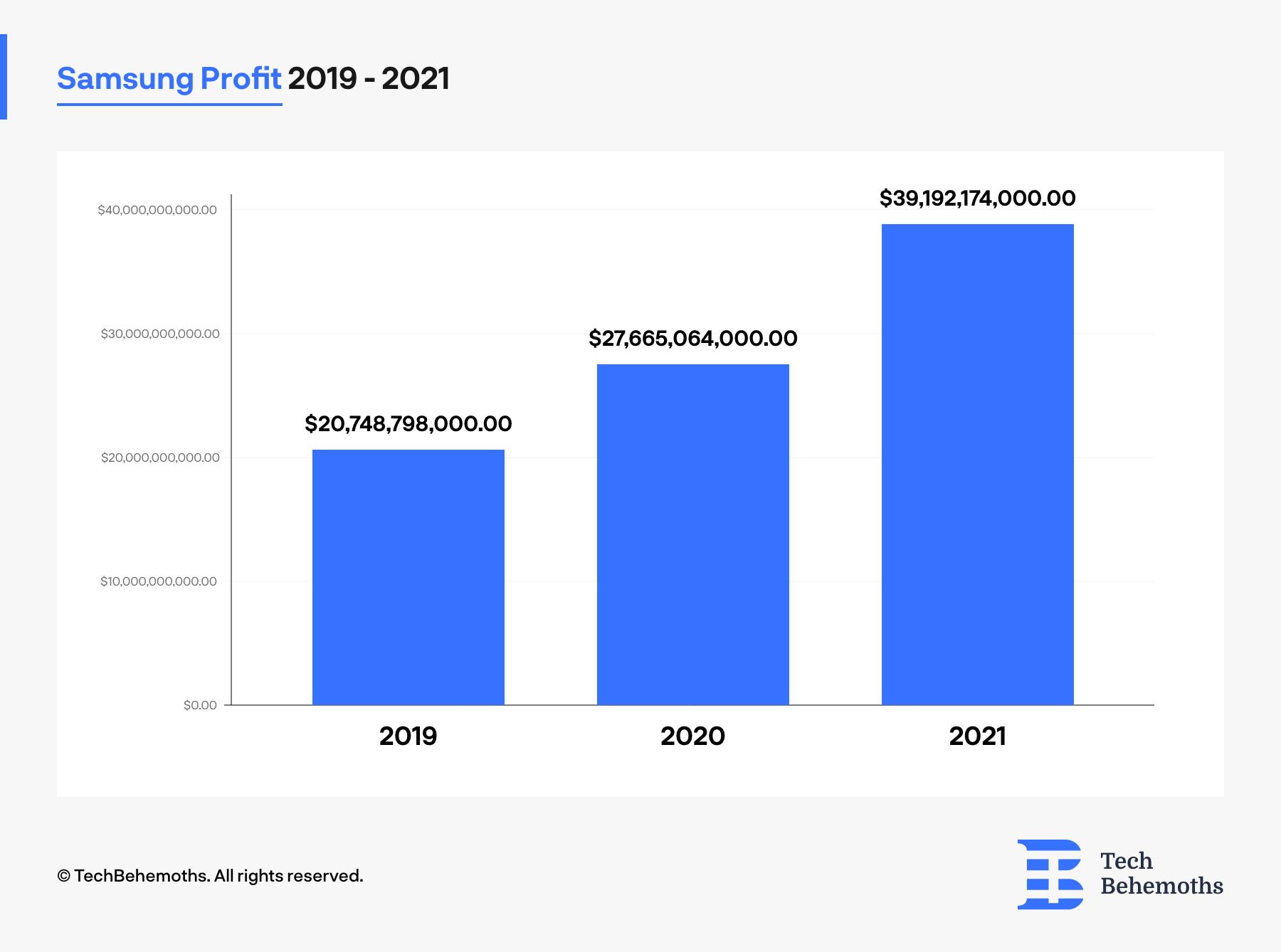
Samsung achieved €46.86 billion in consolidated revenue and €1.94 billion in operating profit in the quarter ending on December 31, 2023. In the full year, it reported €179 billion in annual revenue and €4.54 billion in operating profit.
The fourth-quarter revenue and operating profit showed an increase from the previous quarter, mainly due to improved performance in Memory, which was driven by higher prices. Additionally, the sales of premium display products remained strong, contributing to the overall positive results.
In the first quarter of 2024, the Company's main focus will be on improving profitability. To achieve this, they plan to increase sales of high-value-added products. The component businesses will aim to meet the demand for advanced products, including those aimed at generative AI. On the other hand, the Device eXperience (DX) Division will concentrate on enhancing AI features in smartphones and other consumer products.
The memory market and IT demand are likely to recover further in 2024, despite macroeconomic uncertainty. The company plans to focus on the need for chips for AI applications, while also expanding into AI-enabled consumer goods industries. At the same time, the company plans to strengthen its premium product leadership and competitiveness in advanced-node semiconductors.
Due to ongoing macroeconomic uncertainties, the Company expects the business environment to remain challenging in the short term. As a result, the earnings in the first half of 2024 are expected to show a moderate improvement, while a more significant improvement is anticipated in the second half of the year.
Samsung Electronics Reports Q4 and Full-Year 2024 Financial Results
The company focus on leveraging a diverse business portfolio in combination with technological progress to drive a new phase of growth.
Samsung Electronics shared its financial results for the fourth quarter and the entire year of 2024 in January. For the quarter ending December 31, 2024, the company earned $51.3 billion in total revenue and $4.4 billion in operating profit. For the whole year, it reported $203.6 billion in revenue and $22.1 billion in operating profit.
Despite a decrease in fourth-quarter revenue and operating profit when compared to the previous quarter, annual revenue achieved the second-highest level on record, exceeding only in 2022. At the same time, operating profit experienced a quarterly decline of $1.83 billion due to weak market conditions, particularly for IT products, as well as rising expenses, including those related to R&D.
In the first quarter of 2025, the overall improvement in earnings might be constrained by a downturn in the semiconductor sector. The Company intends to accelerate growth by increasing sales of smartphones that offer unique AI experiences, alongside premium offerings in the Device eXperience (DX) Division.
In 2025, the Samsung Electronics' plans to improve its technology and products in AI and focus on offering high-value products to boost sales in premium markets. The Device Solutions (DS) Division expects a challenging market in the first half of the year, but it will work on becoming a technology leader for future growth. Samsung Display Corporation (SDC) aims to strengthen its position in high-end products by improving competitiveness. The DX Division will focus on leading in delivering AI experiences across a variety of products.
The Company’s capital expenditures totaled $36.3 billion in 2024, which included $31.3 billion allocated to the DS Division and $3.3 billion to SDC. During the fourth quarter, the overall expenditure was $12.0 billion, with $10.8 billion designated for the DS Division and $676 million for SDC.
Stats and Facts about Samsung
- Samsung began to sell noodles and other products, but it wasn't until 1970 that the company sold its first electrical product, a 12-inch black-and-white television.
- Samsung logo change over the years:
- Samsung is a global employer, in over 79 countries with more than 236,000 employees.
- Samsung is always at the leading edge of technology. In 1998, they invented the digital TV, in 1999, the Watch phone and the MP3 phone, and the 3D home theatre in 2010, and in 2013, they invented the world's first curved smartphone display.
- After the Samsung S3 was released, sales at one point exceeded 500 devices per minute.
- The founder of Samsung, Lee Byung-Chull, chose the name Samsung, which in Korean means "three stars", because he visualized his company as being as everlasting as the stars.
- Other than phones, Samsung the Korean behemoth also produces tanks, amphibious assault vehicles, howitzers and other war machines.
(Source: https://www.thefactsite.com/samsung-facts/) - Lee Kun-Hee (a South Korean business magnate who served as the chairman of Samsung Group) was found guilty in 1996 of bribing former president Roh Tae-Woo. He was sentenced to two years in prison, a verdict that the judge commuted, and was amnestied in 1997.
(Source: https://www.britannica.com/topic/Samsung-Electronics)
Conclusion
Samsung has a variety of revenue sources from both technology and consumer discretionary.
However, Samsung warned of a massive challenge in its business outlook, copying global macro risks such as inflation and the Russia-Ukraine war as examples.
Consumers and business clients are reducing their spending to prepare for a possible recession while rising interest rates and costs are directly affecting their disposable income.
Financial records in 2022 are expected to be lower, but now in 2023-2024 the progress is more obvious. Although we are on the brink of an economic crisis, even so, Samsung is trying to invest in the quality of its products and brings innovations to the market that it enjoys.
Related Questions & Answers
What are Samsung Electronics’ main business segments?
Where does Samsung operate globally?
What is Samsung’s largest source of revenue?
What does “Samsung” mean?
Which country owns Samsung?
